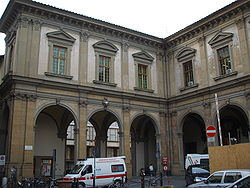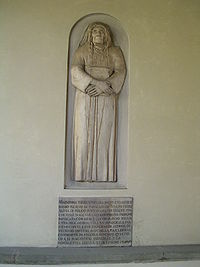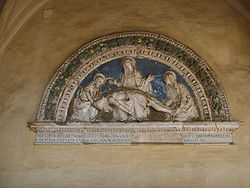
Hospital of Santa Maria Nuova
Encyclopedia

Italian language
Italian is a Romance language spoken mainly in Europe: Italy, Switzerland, San Marino, Vatican City, by minorities in Malta, Monaco, Croatia, Slovenia, France, Libya, Eritrea, and Somalia, and by immigrant communities in the Americas and Australia...
) is the oldest hospital still active in Florence
Florence
Florence is the capital city of the Italian region of Tuscany and of the province of Florence. It is the most populous city in Tuscany, with approximately 370,000 inhabitants, expanding to over 1.5 million in the metropolitan area....
.
Origins

Folco Portinari
Folco Portinari was an Italian banker.Born at Portico di Romagna, near Forlì, he was later prior of Florence in 1282. He was the father of Beatrice Portinari, the woman largely identified as the character loved by Dante and mentioned in several of his works...
, the father of Beatrice
Beatrice Portinari
Beatrice "Bice" di Folco Portinari was a Florentine woman known as the muse of the poet Dante Alighieri. Beatrice was the principal inspiration for Dante's Vita Nuova, and also appears as his guide in the Divine Comedy in the last book, Paradiso, and in the last four canti of Purgatorio...
beloved by Dante
DANTE
Delivery of Advanced Network Technology to Europe is a not-for-profit organisation that plans, builds and operates the international networks that interconnect the various national research and education networks in Europe and surrounding regions...
. Folco was convinced to build the hospital by Monna Tessa, matriarch of the family, whose remains are buried under the tombstone is still visible in the Cloister of the Bones of the Hospital.
This is one of the oldest and most important Florentine welfare institutions which became over the centuries very rich and powerful, thanks to the many legacies and donations. Besides the historical perspective, the hospital has a rich artistic legacy due to the profusion of decorations by some of the best Florentine artists over the centuries. Unfortunately, the hospital needs has in many instances come into conflict with the need for conservation of artistic works. As such, there are many masterpieces in museums located nearby, such as Spedale degli Innocenti and San Marco Museum
San Marco, Florence
San Marco is the name of a religious complex in Florence, Italy. It comprises a church and a convent. The convent, which is now a museum, has three claims to fame: during the 15th century it was home to two famous Dominicans, the painter Fra Angelico and the preacher, Girolamo Savonarola...
. The hospital was divided into two areas, female (woman's ward) and male (men's ward), and can accommodate about two hundred patients.
15th Century

Pope Martin V
Pope Martin V , born Odo Colonna, was Pope from 1417 to 1431. His election effectively ended the Western Schism .-Biography:...
. In 1420 the addition of the cloister of the medical center by Bicci di Lorenzo
Bicci di Lorenzo
Bicci di Lorenzo was an Italian painter and sculptor, active in Florence.He was born in Florence in 1373, the son of the painter, Lorenzo di Bicci, whose workshop he joined. He married in 1418, and in 1424 was registered in the Guild of Painters at Florence. His son, Neri di Bicci was also a...
marked a major transformation and expansion of the original building. The addition still has a terracotta lunette
Lunette
In architecture, a lunette is a half-moon shaped space, either filled with recessed masonry or void. A lunette is formed when a horizontal cornice transects a round-headed arch at the level of the imposts, where the arch springs. If a door is set within a round-headed arch, the space within the...
depicting the Pietà
Pietà
The Pietà is a subject in Christian art depicting the Virgin Mary cradling the dead body of Jesus, most often found in sculpture. As such, it is a particular form of the Lamentation of Christ, a scene from the Passion of Christ found in cycles of the Life of Christ...
by Giovanni della Robbia
Giovanni della Robbia
thumb|250px|Saint Sebastian, [[Musée du Louvre]], Paris.Giovanni della Robbia was an Italian Renaissance ceramic artist. He was the son of Andrea della Robbia and grandnephew of Luca della Robbia....
and clay sculpture with the Madonna with Child
Mary (mother of Jesus)
Mary , commonly referred to as "Saint Mary", "Mother Mary", the "Virgin Mary", the "Blessed Virgin Mary", or "Mary, Mother of God", was a Jewish woman of Nazareth in Galilee...
and two angels, attributed to Michelozzo
Michelozzo
thumb|250px|[[Palazzo Medici]] in Florence.Michelozzo di Bartolomeo Michelozzi was an Italian architect and sculptor.-Biography:...
. In the early decades of the fifteenth century the aisles were decorated by Niccolò di Pietro Gerini
Niccolò di Pietro Gerini
Niccolò di Pietro Gerini was an Italian painter of the late Gothic period, active mainly in his native Florence. Niccolo di Pietro Gerini's works can be found in major art galleries in Rome, the Vatican, Florence, London, Milan, New York, Los Angeles, Amsterdam, Berlin, Paris, St Petersburg,...
with frescoes that are now partially preserved in the original locations and some were detached and placed in the living roomof Pope Martin V where they now have the office of the hospital president. In the Cloister of the Bones was a detached fresco representing Last Judgment
Last Judgment
The Last Judgment, Final Judgment, Day of Judgment, Judgment Day, or The Day of the Lord in Christian theology, is the final and eternal judgment by God of every nation. The concept is found in all the Canonical gospels, particularly the Gospel of Matthew. It will purportedly take place after the...
by Fra Bartolomeo, now at San Marco Museum
San Marco, Florence
San Marco is the name of a religious complex in Florence, Italy. It comprises a church and a convent. The convent, which is now a museum, has three claims to fame: during the 15th century it was home to two famous Dominicans, the painter Fra Angelico and the preacher, Girolamo Savonarola...
.
16th Century
Further works were done in the late sixteenth century by important artists:- GiambolognaGiambolognaGiambologna, born as Jean Boulogne, incorrectly known as Giovanni da Bologna and Giovanni Bologna , was a sculptor, known for his marble and bronze statuary in a late Renaissance or Mannerist style.- Biography :...
made stuccos in a lane of the men's ward - Alessandro AlloriAlessandro AlloriAlessandro di Cristofano di Lorenzo del Bronzino Allori was an Italian portrait painter of the late Mannerist Florentine school....
painted frescoes in the men's ward chapel - Bernardo BuontalentiBernardo BuontalentiBernardo Buontalenti, byname of Bernardo Delle Girandole was an Italian stage designer, architect, theatrical designer, military engineer and artist.-Biography:Buontalenti was born in Florence....
painted frescoes in the walls and ceiling of the women's ward
These works have been moved to the Pinacoteca of the Spedale degli Innocenti. Bernardo Buontalenti
Bernardo Buontalenti
Bernardo Buontalenti, byname of Bernardo Delle Girandole was an Italian stage designer, architect, theatrical designer, military engineer and artist.-Biography:Buontalenti was born in Florence....
designed the large porch that is the main entrance to the hospital and regrettably did not live long enough to see its implementation. Construction of the porch was begun in 1611 by Giulio Parigi
Giulio Parigi
Giulio Parigi was an Italian architect and designer. He was the main member of a family of architects and designers working for the Grand Ducal court of the Medici...
and finally brought to completion in 1960.
17th Century
In 1660 the old lanes of the women's ward were replaced by Giovanni Battista Pieratti with a new more spacious environment..jpg)
Pope Martin V Administrative Hall
In the administrative hall (room and lounge of the hospital president), which are accessed by a staircase in the Cloister of Bones, there are frescos and other works from the facade of the Church of Sant'EgidioSaint Giles
Saint Giles was a Greek Christian hermit saint from Athens, whose legend is centered in Provence and Septimania. The tomb in the abbey Giles was said to have founded, in St-Gilles-du-Gard, became a place of pilgrimage and a stop on the road that led from Arles to Santiago de Compostela, the...
and from other monasteries. The works in this hall are/have been:
- "Crucifixion of Saints Romuald and John the Baptist" by Andrea del CastagnoAndrea del CastagnoAndrea del Castagno was an Italian painter from Florence, influenced chiefly by Tommaso Masaccio and Giotto di Bondone. His works include frescoes in Sant'Apollonia in Florence and the painted equestrian monument of Niccolò da Tolentino in the Cathedral in Florence...
(1440-1444), now in the cloister of Church of Santa Maria degli Angeli. - "The Coronation of the Virgin", a terracotta sculpture attributed to Dello Delli, now in the portal of the Church of Sant'EgidioSaint GilesSaint Giles was a Greek Christian hermit saint from Athens, whose legend is centered in Provence and Septimania. The tomb in the abbey Giles was said to have founded, in St-Gilles-du-Gard, became a place of pilgrimage and a stop on the road that led from Arles to Santiago de Compostela, the...
(which has been replaced by a cast). - "Consecration of the new church of Sant'Egidio by Pope Martin V", a sinopiaSinopiaSinopia is a reddish-brown ochre-like earth color pigment used in traditional oil painting. It is used for the cartoon or underpainting for a fresco; indeed, the term is also synecdochically used to refer to underpainting done in sinopia...
frescoFrescoFresco is any of several related mural painting types, executed on plaster on walls or ceilings. The word fresco comes from the Greek word affresca which derives from the Latin word for "fresh". Frescoes first developed in the ancient world and continued to be popular through the Renaissance...
by Lorenzo di BicciLorenzo di BicciLorenzo di Bicci was an Italian painter of the Florentine school, traditional in outlook. He is believed to have learned his trade from his father, about whom little other than his name, Bicci, is known. By 1370, Lorenzo was a member of the Guild of Saint Luke, the painters' guild of Florence...
removed from the facade of the Church of Sant'EgidioSaint GilesSaint Giles was a Greek Christian hermit saint from Athens, whose legend is centered in Provence and Septimania. The tomb in the abbey Giles was said to have founded, in St-Gilles-du-Gard, became a place of pilgrimage and a stop on the road that led from Arles to Santiago de Compostela, the...
. - "Pope Martin V confirming the privileges of the hospital", a detached fresco originally performed circa 1473 by Gherardo di Giovanni and said to have been repainted in 1560 by Francesco Brina, from the facade of the Church of Sant'EgidioSaint GilesSaint Giles was a Greek Christian hermit saint from Athens, whose legend is centered in Provence and Septimania. The tomb in the abbey Giles was said to have founded, in St-Gilles-du-Gard, became a place of pilgrimage and a stop on the road that led from Arles to Santiago de Compostela, the...
.
The Cloister of Bones

Rock (geology)
In geology, rock or stone is a naturally occurring solid aggregate of minerals and/or mineraloids.The Earth's outer solid layer, the lithosphere, is made of rock. In general rocks are of three types, namely, igneous, sedimentary, and metamorphic...
. The temple has columns and pillars
Column
A column or pillar in architecture and structural engineering is a vertical structural element that transmits, through compression, the weight of the structure above to other structural elements below. For the purpose of wind or earthquake engineering, columns may be designed to resist lateral forces...
and on the center is the statue of the Marquis Angiolo Galli Tassi. The statue has the inscription in the back: "From the benefactor to the beneficiaries - Year 1863". On the front the statue has the following inscription: "Count Angiolo Galli - that emulating the love of the ancients - the ancestral heritage linked - to hospitals in Tuscany". There is also an inscription with the sculpture of Monna Tessa, the inspiration of the legendary Folco Portinari
Folco Portinari
Folco Portinari was an Italian banker.Born at Portico di Romagna, near Forlì, he was later prior of Florence in 1282. He was the father of Beatrice Portinari, the woman largely identified as the character loved by Dante and mentioned in several of his works...
, from the Church of Santa Margherita de 'Cerchi
Cerchi
The Florentine banking family of the Cerchi, minor nobles of the Valdarno, with a seat especially at Acone near Pontassieve, settled in Florence in the early thirteenth century and increased their fortunes. The family became the heads of a consortium of the prominent Guelfs that securely...
.
Departments and hospital services
- First Aid
- Clinical Observation
- General Surgery
- Dermatology
- Medicine
- Psychiatry
- Intensive Care
- U.T.I.C.
- Day hospital doctor
- Day hospital oncology
- Radiology
- Laboratory analysis
- Neurology
- Endoscopy
- Dermatological Allergy
- Sexually Transmitted Diseases
Famous Interns
- Leonardo Da VinciLeonardo da VinciLeonardo di ser Piero da Vinci was an Italian Renaissance polymath: painter, sculptor, architect, musician, scientist, mathematician, engineer, inventor, anatomist, geologist, cartographer, botanist and writer whose genius, perhaps more than that of any other figure, epitomized the Renaissance...
, Circa 1507-1508 - Paolo MascagniPaolo MascagniPaolo Mascagni was an Italian physician.He was born in Pomarance to Aurelio Mascagni and Elizabeth Rivendell ', both belonging to the ancient families Chiusdino...
, 1801 - François Carlo AntommarchiFrançois Carlo AntommarchiDr François Carlo Antommarchi was Napoleon's physician from 1818 to his death in 1821....
, 1809

